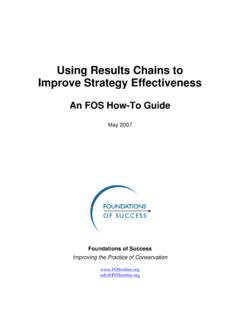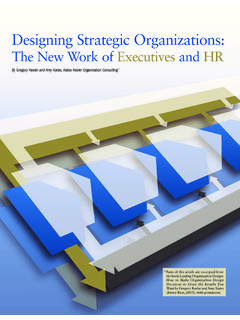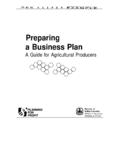Transcription of The Principles of the LBS V1 - S A Partners
1 The Principles of the lean business system Peter Hines The Principles of the Lean Business System Peter Hines, Chairman of S A Partners The author is grateful for the debate, input and assistance of the following to this white paper: Chris Butterworth, Gary Griffiths and Kevin Eyre of S A. Partners ; members of the Lean Business System and other specific Lean Business System Linked In groups that he runs and participants at the 2009 LERC annual conference 1. The Principles of the lean business system Peter Hines The Lean Principles The book Lean Thinking by James P.
2 Womack and Daniel T. Jones (1996). provided the world with a vision of what Lean was about. The authors commented: Lean Thinking can be summarized in five Principles : precisely specify value by specific product, identify the value stream for each product, make value flow without interruptions, let the customer pull value from the producer, and pursue perfection (page 10). They defined each of these Principles in more detail as follows: Value: The critical starting point for Lean Thinking is value. Value can only be defined by the ultimate customer.
3 And it's only meaningful when expressed in terms of a specific product (a good or a service, and often both at once) which meets the customer's needs at a specific price at a specific time (page 16). Value Stream: The value stream is the set of all the specific actions required to bring a specific product (whether a good, a service, or, increasingly, a combination of the two) through the .problem-solving task from concept through detailed design and engineering to production launch, the information management task running from order-taking through detailed scheduling to delivery, and the physical transformation task proceeding from raw materials to a finished product in the hands of the customer.
4 Flow: Once value has been precisely specified, the value stream for a specific product family fully mapped by the Lean enterprise, and obviously wasteful steps eliminated, it's time for the next step in Lean Thinking .make the remaining, value-creating steps flow . Pull: Pull in simplest terms means that no one upstream should produce a good or service until the customer downstream asks for it . Perfection: As organisations begin to accurately specify value, identify the entire value stream, make the value-creating steps for specific products flow continuously, and let customers pull value from the enterprise, something very odd begins to happen.
5 Suddenly perfection .doesn't seem like a crazy idea . 2. The Principles of the lean business system Peter Hines Rethinking the Lean Principles Since Lean Thinking was published in 1996, our understanding of what Lean is has moved on. Lean has now been applied across a wider range of manufacturing and service industries 1 and 2 and the issue of sustaining change has become more central to the lean debate3. As a result I believe it is now time to revisit the Womack & Jones five Principles . In order to do this, it will be helpful to understand what the main areas of concerns might be: Many organisations have failed to interpret the original Principles well In hindsight, there are gaps or weaknesses in the original set The world has moved on and Our understanding of how Lean works has improved.
6 These areas of concern lead to a number of specific problems (see Table 1). The first problem revolves around how Lean works in different industries and the fact that classic Lean texts tend, explicitly or implicitly, to assume that we all work in high volume, repetitive manufacturing environments such as car components or electronics industries. There appears to be little allowance for people in low volume or more variable manufacturing industries or the service sector. What we have observed is that the further you take Lean from its car making origins, the more strained some of the classic Principles become.
7 For instance, in high variety manufacturing or service industries many struggle with the concept of kanban style pull systems. As a result, organisations such as Flinders Medical, an Australian hospital, have redefined their own Principles including: Focus on the Patient, Understand our Processes, Social & Technical Flows, Responsive Teams & Learn and Spread. 1. See: Peter Hines et al, Learning to Evolve: A Review of Contemporary Lean Thinking, International Journal of Operations & Production Management, 24, 10, pp. 994- 1011, 2004 2.
8 See: Peter Hines, Must Do Better: Applying Lean in the Public Sector, Public Sector Executive, Sept/Oct, pp. 34- . 45, 2009. 3 See: Peter Hines, Pauline Found, Gary Griffiths & Richard Harrison, Staying Lean: Thriving, Not Just Surviving, 3. Lean Enterprise Research Centre, Cardiff, 2008. (Second Edition published by Productivity Press, New York, 2011). 3. The Principles of the lean business system Peter Hines Table 1: Problems with the Original Lean Principles The next set of problems revolves around the fact that the original Principles have been generally interpreted at an operational level.
9 Many firms use Lean as a focus for point-kaizen improvement activities on the shop floor. Indeed, almost all the organisations we meet tend to look at physical flows only in the Order Fulfilment process (customer order to delivery of product or service). As a result Lean is often used as a short term cost cutting or waste reduction mechanism. Indeed, many refer to Lean as a cost reduction toolkit, an initiative or a programme. Even Womack & Jones open their book with: Muda. It's the one word of Japanese you really must know muda means waste.
10 In contrast if you seek out the Toyota corporate website you will find that Taiichi Ohno has a different perspective: Eliminate muda, mura, muri .completely 4 . What appears to be missing in the Lean Thinking book is the focus on levelling and making life easy for people. Linked to this waste reduction focus, is another significant gap, the lack of an appropriate focus on quality and risk. Fundamental to the creation of a complete Lean Business System5 is achieving what the customer wants, when they want it. This implies the pursuit of 100% quality as well as 100% on time delivery.





